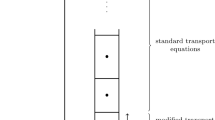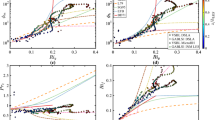Abstract
Forcing relationships in steady, neutrally stratified atmospheric boundary-layer (ABL) flow are thoroughly analyzed. The ABL flow can be viewed as balanced between a forcing and a drag term. The drag term results from turbulent stress divergence, and above the ABL, both the drag and the forcing terms vanish. In computational wind engineering applications, the ABL flow is simulated not by directly specifying a forcing term in the ABL but by specifying boundary conditions for the simulation domain. Usually, these include the inflow boundary and the top boundary conditions. This ‘boundary-driven’ ABL flow is dynamically different from its real counterpart, and this is the major reason that the simulated boundary-driven ABL flow does not maintain horizontal homogeneity. Here, first a dynamical approach is proposed to develop a neutrally stratified equilibrium ABL flow. Computational fluid dynamics (CFD) software (Fluent 6.3) with the standard \(k\)–\(\varepsilon \) turbulence model is employed, and by applying a driving force profile, steady equilibrium ABL flows are simulated by the model. Profiles of wind speed and turbulent kinetic energy (TKE) derived using this approach are reasonable in comparison with the conventional logarithmic law and with observational data respectively. Secondly, the equilibrium ABL profiles apply as inflow conditions to simulate the boundary-driven ABL flow. Simulated properties between the inlet and the outlet sections across a fetch of 10 km are compared. Although profiles of wind speed, TKE, and its dissipation rate are consistently satisfactory under higher wind conditions, a deviation of TKE and its dissipation rate between the inlet and outlet are apparent (7–8 %) under lower wind-speed conditions (2 m s\(^{-1}\) at 10 m). Furthermore, the simulated surface stress systematically decreases in the downwind direction. A redistribution of the pressure field is also found in the simulation domain, which provides a different driving pattern from the realistic case in the ABL.









Similar content being viewed by others
References
Andren A, Brown AR, Graf ZJ, Mason PJ, Moeng C-H, Nieuwstadt FTM, Schumann U (1994) Large-eddy simulation of a neutrally stratified boundary layer: a comparison of four computer codes. Q J R Meteorol Soc 120:1457–1484
Apsley DD, Castro IP (1997) A limited-length-scale \(K\)–\(\varepsilon \) model for the neutral and stably-stratified atmospheric boundary layer. Boundary-Layer Meteorol 83:75–98
Blocken B, Gualtieri C (2012) Ten iterative steps for model development and evaluation applied to computational fluid dynamics for environmental fluid mechanics. Environ Modell Softw 33:1–22
Blocken B, Stathopoulos T, Carmeliet J (2007) CFD simulation of the atmospheric boundary layer: wall function problems. Atmos Environ 41:238–252
Brost RA, Wyngaard JC, Lenschow DH (1982) Marine stratocumulus layers. Part II: turbulence budgets. J Atmos Sci 39:818–836
Detering HW, Etling D (1985) Application of the \(E\)–\(\varepsilon \) turbulence model to the atmospheric boundary layer. Boundary-Layer Meteorol 33:113–133
Esau I (2004) Simulation of Ekman boundary layers by large eddy model with dynamic mixed subfilter closure. Environ Fluid Mech 4:273–303
Fluent Inc (2006) Fluent 6.3 User’s Guide. Fluent Inc, Lebanon
Franke J (2006) Recommendations of the Cost Action C14 on the use of CFD in predicting pedestrian wind environment. In: Proceedings of the fourth international symposium on computational wind engineering, Yokohama, Japan, July 2006
Garratt JR (1992) The atmospheric boundary layer, vol New York. Cambridge University Press, UK 316 pp
Grant ALM (1986) Observations of boundary layer structure made during the 1981 KONTUR experiment. Q J R Meteorol Soc 112:825–841
Gorlé C, van Beeck J, Rambaud P, Van Tendeloo G (2009) CFD modelling of small particle dispersion: the influence of the turbulence kinetic energy in the atmospheric boundary layer. Atmos Environ 43:673–681
Hanna SR (1982) Applications in air pollution modeling. In: Nieuwstadt FTM, Van Dop H (eds) Atmospheric turbulence and air pollution modelling. D. Reidel Publishing Company, Dordrecht, pp 275–310
Hargreaves D, Wright N (2007) On the use of the \(K\)–\(\varepsilon \) model in commercial CFD software to model the neutral atmospheric boundary layer. J Wind Eng Ind Aerodyn 95:355–369
Launder BE, Spalding DB (1974) The numerical computation of turbulent flows. Comput Methods Appl Mech Eng 3:269–289
Nieuwstadt FTM, Duynkerke PG (1996) Turbulence in the atmospheric boundary layer. Atmos Res 40:111–142
O’Sullivan JP, Archer RA, Flay RGJ (2011) Consistent boundary conditions for flows within the atmospheric boundary layer. J Wind Eng Ind Aerodyn 99:65–77
Panofsky HA, Dutton JA (1984) Atmospheric turbulence, models and methods for engineering applications. Wiley, New York
Parente A, Gorlé C, van Beeck J, Benocci C (2011a) Improved k-\(\varepsilon \) model and wall function formulation for the RANS simulation of ABL flows. J Wind Eng Ind Aerodyn 99:267–278
Parente A, Gorlé C, van Beeck J, Benocci C (2011b) A comprehensive modelling approach for the neutral atmospheric boundary layer: consistent inflow conditions, wall function and turbulence model. Boundary-Layer Meteorol 140:411–428
Peña A, Gryning S-E, Mann J, Hasager CB (2010) Length scales of the neutral wind profile over homogeneous terrain. J Appl Meteorol Climatol 49:792–806
Porte-Agel F, Meneveau C, Parlange MB (2000) A scale-dependent dynamic model for large-eddy simulation: application to a neutral atmospheric boundary layer. J Fluid Mech 415:261–284
Richards PJ, Hoxey RP (1993, RH1993) Appropriate boundary conditions for computational wind engineering models using the \(K\)–\(\varepsilon \) turbulence model. J Wind Eng Ind Aerodyn 46 & 47:145–153
Richards PJ, Norris SE (2011) Appropriate boundary conditions for computational wind engineering models revisited. J Wind Eng Ind Aerodyn 99:257–266
Sumner J, Masson C (2012) \(k\)–\(\varepsilon \) simulations of the neutral atmospheric boundary layer: analysis and correction of discretization errors on practical grids. Int J Numer Methods Fluids 70:724–741
Tominaga Y, Mochida A, Yoshie R, Ktaoka H, Nozu T, Yoshikawa M, Shirasawa T (2008) AIJ guidelines for practical applications of CFD to pedestrian wind environment around buildings. J Wind Eng Ind Aerodyn 96:1749–1761
Wyngaard JC (2010) Turbulence in the atmosphere. Cambridge University Press, U.S.A. 393 pp
Xu D, Taylor PA (1997) An \(E\)–\(\varepsilon \)–\(l\) turbulence closure scheme for planetary boundary-layer models: the neutrally stratified case. Boundary-Layer Meteorol 84:247–266
Yang Y, Gu M, Chen S, Jin X (2009) New inflow boundary conditions for modelling the neutral equilibrium atmospheric boundary layer in computational wind engineering. J Wind Eng Ind Aerodyn 97:88–95
Zilitinkevich SS, Esau IN (2002) On integral measures of the neutral barotropic planetary boundary layer. Boundary-Layer Meteorol 104:371–379
Acknowledgments
Project 2010CB428501 supported by Chinese Ministry of Science and Technology. Project 41121004 and 41075004 supported by NSFC. Public Welfare Projects for Environmental Protection (No. 201309009) supported by Ministry of Environment Protection of China. The authors appreciate the anonymous reviewers for their very sharp and valuable comments that greatly helped to improve the manuscript.
Author information
Authors and Affiliations
Corresponding author
Appendices
Appendix A: Variances in the Turbulent Velocity
According to Hanna (1982), the profiles of the standard deviations of turbulent velocities in the neutral atmospheric boundary layer are specified as,
where \(h\) is the ABL height, taking the form of Eq. 13, and \(c\) is a coefficient. As a result, the ratio of \(k/u_*^2 =0.5(\sigma _u^2 +\sigma _v^2 +\sigma _w^2 )/u_*^2 \) can be calculated in the ABL.
Appendix B: Standard \(k\)–\(\varepsilon \) Model and Constants
The standard \(k\)–\(\varepsilon \) turbulence model resolves two additional equations for turbulent kinetic energy \((k)\) and its dissipation rate \(\varepsilon \), viz. (Launder and Spalding 1974),
where
All symbols have their conventional meanings, and \(\sigma _k,\sigma _\varepsilon ,C_{\varepsilon 1},C_{\varepsilon 2} \) and \(C_\mu \) are model constants usually taking the standard values of 1.0, 1.3, 1.44, 1.92, and 0.09, respectively. In the surface layer, it is deduced that (RH1993; Apsley and Castro 1997; Detering and Etling 1985)
where \(\kappa \) is the von Karman constant. The relationship in Eq. 22 is usually applied to turbulence in the whole ABL. According to Detering and Etling (1985), the set of constants adjusted to fit observations of atmospheric TKE in our study can be taken as \((\sigma _k,\sigma _\varepsilon ,C_{\varepsilon 1},C_{\varepsilon 2},C_\mu ) = (1, 1, 1.13, 1.92, 0.0494)\). These constants satisfy Eq. 22, given the von Karman constant (0.4187) in Fluent.
Rights and permissions
About this article
Cite this article
Cai, X., Huo, Q., Kang, L. et al. Equilibrium Atmospheric Boundary-Layer Flow: Computational Fluid Dynamics Simulation with Balanced Forces. Boundary-Layer Meteorol 152, 349–366 (2014). https://doi.org/10.1007/s10546-014-9928-0
Received:
Accepted:
Published:
Issue Date:
DOI: https://doi.org/10.1007/s10546-014-9928-0




